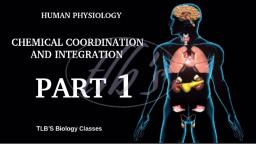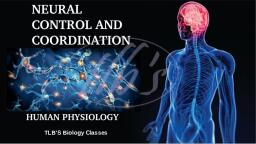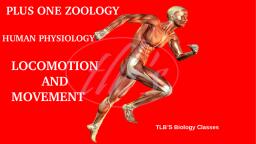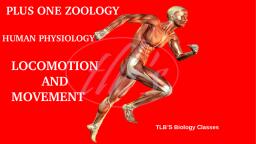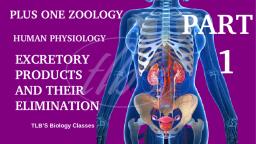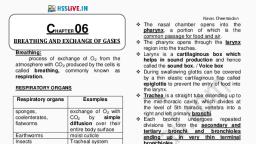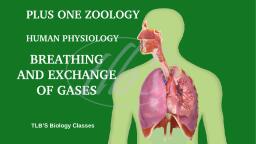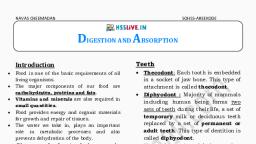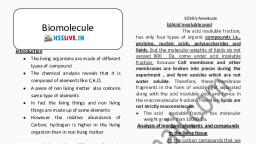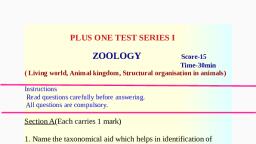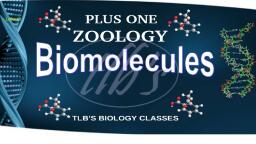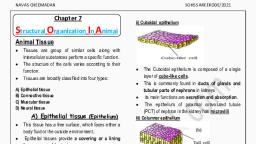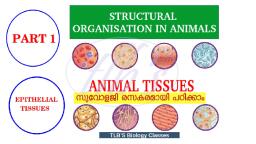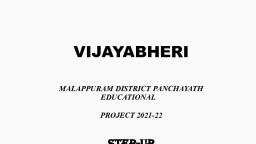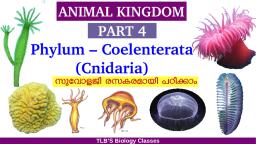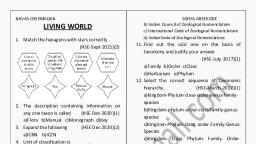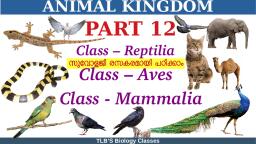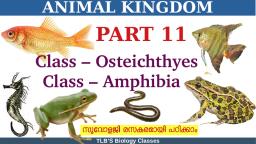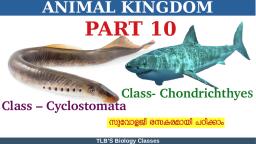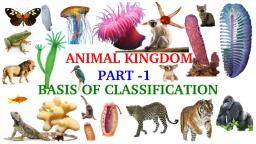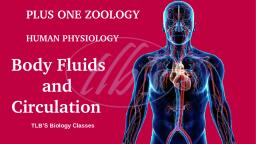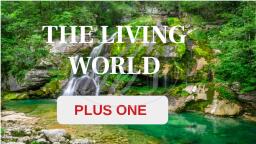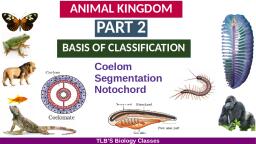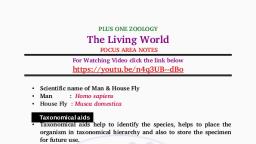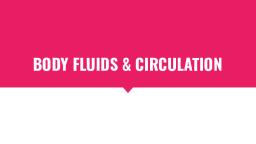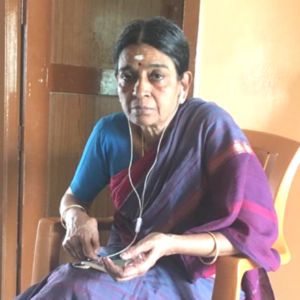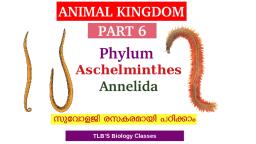Page 1 :
PLUS ONE ZOOLOGY, HUMAN PHYSIOLOGY, , Body Fluids, and, Circulation, TLB’S Biology Classes
Page 2 :
Body Fluids and Circulation, , WHAT IS CIRCULATION?, , TLB’S Biology Classes, , 2
Page 3 :
Body Fluids and Circulation, WHAT IS CIRCULATION?, ●, , Circulation is the transport of nutrients, oxygen,, CO2 and excretory products to the concerned, tissues or organs., , ●, , For circulation, simple organisms, , ●, , (sponges, coelenterates etc) use water from, their surroundings., , ●, , Complex organisms use body fluids, (blood & lymph) for circulation., , TLB’S Biology Classes, , 3
Page 4 :
Body Fluids and Circulation, WHAT IS CIRCULATION?, , ●, , In this chapter, We can learn about, the composition and properties of, blood and lymph (tissue fluid) and, the, , mechanism, , of, , circulation, , of, , blood., , TLB’S Biology Classes, , 4
Page 5 :
Body Fluids and Circulation, BLOOD, , ●, , Blood is a special connective, tissue consisting of a, , matrix,, , plasma,, , fluid, and, , formed elements., , TLB’S Biology Classes, , 5
Page 6 :
Body Fluids and Circulation, , PLASMA, , TLB’S Biology Classes, , 6
Page 7 :
Body Fluids and Circulation, PLASMA, ●, , Plasma is a straw coloured, viscous fluid, constituting nearly 55 per cent of, the blood., , ●, , 90-92 per cent of plasma is water and, proteins contribute 6-8 per cent of it., , ●, , Fibrinogen,, , ●, , globulins and, , ●, , albumins are the major plasma proteins., TLB’S Biology Classes, , 7
Page 8 :
Body Fluids and Circulation, Functions of Plasma Proteins, ●, ●, ●, , Fibrinogens are needed for clotting or coagulation of blood., Globulins are involved in defense mechanisms of the body, Albumins help in osmotic balance., , TLB’S Biology Classes, , 8
Page 9 :
Body Fluids and Circulation, Plasma, ●, , ●, , ●, , ●, , Plasma also contains small amounts of, minerals like Na+ , Ca++ , Mg++ , HCO3– ,, Cl – , etc., Glucose, amino acids, lipids, etc., are also, present in the plasma as they are always in, transit in the body., Factors for coagulation or clotting of blood, are also present in the plasma in an, inactive form., Plasma without the clotting factors is called, , serum., TLB’S Biology Classes, , 9
Page 10 :
Body Fluids and Circulation, , FORMED ELEMENTS, , TLB’S Biology Classes
Page 11 :
Body Fluids and Circulation, FORMED ELEMENTS, , ●, , Erythrocytes,, , ●, , leucocytes and, , ●, , platelets are collectively, , Red, Red Blood, Blood Cells, Cells (RBC), (RBC), or, or Erythrocytes, Erythrocytes, , FORMED, FORMED, ELEMENTS, ELEMENTS, , White, White Blood, Blood Cells, Cells, (WBC), (WBC) or, or Leucocytes, Leucocytes, , called formed elements., ●, , They constitute nearly 45 per, cent of the blood., , Platelets, Platelets, (Thrombocytes), (Thrombocytes), TLB’S Biology Classes
Page 12 :
Body Fluids and Circulation, , Erythrocytes or red blood cells (RBC), , TLB’S Biology Classes
Page 13 :
Body Fluids and Circulation, Erythrocytes or red blood cells (RBC), ●, , Erythrocytes or red blood cells (RBC) are the, most abundant of all the cells in blood., , ●, , A healthy adult man has, on an average,, 5 millions to 5.5 millions of RBCs mm–3, of blood., , ●, , RBCs are formed in the red bone marrow in the, adults., , ●, , RBCs are devoid of nucleus in most of the, mammals., , ●, , They are biconcave in shape., TLB’S Biology Classes
Page 14 :
Body Fluids and Circulation, Erythrocytes or red blood cells (RBC), ●, , They have a red coloured, iron containing, complex protein called, , ●, , A, , healthy, , haemoglobin., , individual, , has, , 12-16, , gms, , of, , haemoglobin in every 100 ml of blood., ●, , These molecules play a significant role in, transport of respiratory gases., , ●, , RBCs have an average life span of 120 days after, which they are destroyed in the, , spleen (graveyard of RBCs)., , TLB’S Biology Classes
Page 15 :
Body Fluids and Circulation, Features of RBC (Erythrocytes), Colour, , Red (due to haemoglobin)., Normal Hb level in blood:, 12-16 gm/ 100 ml, , Lifespan, , 120 days, , Count, , 5 - 5.5 millions/mm3, , Formed in, , Red bone marrow, , Structure, , Biconcave in shape. No nucleus, , Functions, , significant role in transport of, respiratory gases., TLB’S Biology Classes
Page 17 :
Body Fluids and Circulation, Leucocytes or white blood cells (WBC), ●, , Leucocytes are also known as white, blood, , cells, , colourless, , (WBC), due, , to, , as, the, , they, , are, , lack, , of, , haemoglobin., ●, , They are nucleated and are relatively, lesser in number which averages 60008000 mm–3 of blood., , ●, , Leucocytes are generally short lived., , TLB’S Biology Classes
Page 20 :
Body Fluids and Circulation, Agranulocytes, , ●, ●, , Lymphocytes and, Monocytes are the agranulocytes., , 1. Monocytes, (6-8 per cent) are phagocytic cells which, destroy foreign organisms entering the body, , 2. Lymphocytes, (20-25%), responsible for immune response, of the body., ●, , B and T lymphocytes are present, , TLB’S Biology Classes
Page 21 :
Body Fluids and Circulation, , TLB’S Biology Classes
Page 22 :
Body Fluids and Circulation, Platelets (thrombocytes), ●, , These are cell fragments produced from, megakaryocytes (special cells in the bone, marrow), , ●, , Normal count is 1,500,00 to 3,500,00 in mm-3, , ●, , Main function is blood clotting., , ●, , A reduction in their number can lead to, clotting disorders which will lead to excessive, loss of blood from the body., , TLB’S Biology Classes
Page 23 :
Body Fluids and Circulation, , TLB’S Biology Classes
Page 24 :
Body Fluids and Circulation, , TLB’S Biology Classes
Page 25 :
Body Fluids and Circulation, , TLB’S Biology Classes
Page 26 :
Body Fluids and Circulation, Blood Groups, , ●, , ●, , Various types of grouping of, blood has been done., Two such groupings – the ABO, and Rh – are widely used all, over the world., , Karl Landsteiner, TLB’S Biology Classes
Page 28 :
Body Fluids and Circulation, ABO grouping, ●, , ABO grouping is based on the, presence or absence of two surface, antigens, , (chemicals, , that, , can, , induce immune response) on the, RBCs namely A and B., ●, , Similarly, the plasma of different, individuals contain two natural, antibodies (proteins produced in, response to antigens)., , TLB’S Biology Classes
Page 29 :
Body Fluids and Circulation, ABO grouping, ●, , During, , blood, , transfusion,, , any, , blood cannot be used; the blood of, a, , donor, , has, , to, , be, , carefully, , matched with the blood of a, recipient, transfusion, , before, to, , any, , blood, , avoid, , severe, , problems of clumping (destruction, of RBC)., , TLB’S Biology Classes
Page 33 :
Body Fluids and Circulation, ‘universal donors’ and ‘universal recipients’, ●, , Group ‘O’ blood can be donated to persons, with any other blood group and hence ‘O’, group individuals are called, , ‘universal, , donors’., ●, , Persons with ‘AB’ group can accept blood, from persons with AB as well as the other, groups of blood., , ●, , Therefore,, , such, , persons, , are, , called, , ‘universal recipients’., TLB’S Biology Classes
Page 34 :
Body Fluids and Circulation, , Rh grouping, , TLB’S Biology Classes
Page 35 :
Body Fluids and Circulation, Rh grouping, ●, , Another antigen, the Rh antigen similar, to one present in Rhesus monkeys (hence, Rh), is also observed on the surface of, RBCs of majority (nearly 80 per cent) of, humans., , ●, , Such individuals are called Rh positive, (Rh+ve) and those in whom this antigen is, absent are called Rh negative (Rh-ve)., , TLB’S Biology Classes
Page 36 :
Body Fluids and Circulation, Rh grouping, ●, , ●, , An Rh-ve person, if exposed to Rh+ve blood, will form specific antibodies against the, Rh antigens., Therefore, Rh group should also be matched before transfusions., , TLB’S Biology Classes
Page 38 :
Body Fluids and Circulation, Erythroblastosis Foetalis, , ●, , A special case of Rh incompatibility, (mismatching) has been observed, between, , the, , Rh-ve, , blood of a, , pregnant mother with Rh+ve blood, of the foetus., , TLB’S Biology Classes
Page 39 :
Body Fluids and Circulation, , TLB’S Biology Classes
Page 40 :
Body Fluids and Circulation, , TLB’S Biology Classes
Page 41 :
Body Fluids and Circulation, Erythroblastosis Foetalis, , ●, , This can be seen in Rh positive, foetus which is developing in the, uterus of Rh negative lady who, became pregnant in the second, time., , ●, , During the delivery of first child, mixing of maternal and foetal, blood occurs ., , TLB’S Biology Classes
Page 42 :
Body Fluids and Circulation, Erythroblastosis Foetalis, ●, , Then the mother begins to produce, antibodies against Rh antigen in her, blood., , ●, , This Rh antibody enters in to the, foetus if the lady conceives the, second child and destroy the foetal, RBC., , TLB’S Biology Classes
Page 44 :
Body Fluids and Circulation, Erythroblastosis Foetalis, , ●, , This, , can, , be, , avoided, , by, , administering anti-Rh antibodies, to the mother immediately after, the delivery of the first child., , TLB’S Biology Classes
Page 45 :
Body Fluids and Circulation, , TLB’S Biology Classes
Page 46 :
Body Fluids and Circulation, , Coagulation of Blood, , TLB’S Biology Classes
Page 47 :
Body Fluids and Circulation, Coagulation of Blood, ●, , Blood, , exhibits, , clotting, , or, , coagulation in response to an, injury, , in, , order, , to, , prevent, , excessive loss of blood from the, body., , TLB’S Biology Classes
Page 48 :
Body Fluids and Circulation, Coagulation of Blood, , ●, , Clotting involves the conversion, of, , soluble, , plasma, , protein, , fibrinogen into an insoluble form, called fibrin., ●, , This reaction is catalysed by the, enzyme thrombin., , TLB’S Biology Classes
Page 49 :
Body Fluids and Circulation, Coagulation of Blood, ●, , Thrombin is found in the blood in an inactive form called prothrombin., , ●, , The enzyme complex thrombokinase converts prothrombin to thrombin, through a series of reactions., , TLB’S Biology Classes
Page 50 :
Body Fluids and Circulation, Coagulation of Blood, ●, , Thromboplastin, , released, , from, , platelets and damaged tissues, initiates, , the, , formation, , of, , thrombokinase, ●, , Ca2+ ions are essential for the, activation, , and, , action, , of, , thrombin., , TLB’S Biology Classes
Page 51 :
Body Fluids and Circulation, , TLB’S Biology Classes
Page 52 :
Body Fluids and Circulation, LYMPH (TISSUE FLUID), ●, , When blood flows under high pressure, through the capillaries, water and other, dissolved substances are filtered out, from, , the, , blood, , plasma, , to, , the, , intercellular space., ●, , This fluid released out is called the, , interstitial fluid or tissue fluid., , TLB’S Biology Classes
Page 53 :
Body Fluids and Circulation, LYMPH (TISSUE FLUID), ●, , It has the same mineral distribution as that, in plasma., , ●, , Exchange of nutrients, gases, etc., between, the blood and the cells always occur, through this fluid., , ●, , An elaborate network of vessels called the, , lymphatic system collects this fluid, and drains it back to the major veins., ●, , The fluid present in the lymphatic system is, called the, , lymph., TLB’S Biology Classes
Page 54 :
Body Fluids and Circulation, FUNCTIONS OF LYMPH, , ●, , Lymph is a colourless fluid containing, specialised lymphocytes which are, responsible for the immune responses, of the body., , ●, , Lymph is also an important carrier, for nutrients, hormones, etc., , TLB’S Biology Classes
Page 55 :
Body Fluids and Circulation, FUNCTIONS OF LYMPH, , ●, , Fats are absorbed through lymph in, the, , lacteals, , present, , in, , the, , intestinal villi., , TLB’S Biology Classes
Page 56 :
Body Fluids and Circulation, , TLB’S Biology Classes
Page 57 :
Body Fluids and Circulation, CIRCULATORY PATHWAYS, ●, , The circulatory pathways are of two, types –, , open or closed., , Open Circulatory System, ●, , Blood from heart passes through, large vessels into open spaces or, body cavities called sinuses, , ●, , Eg . Arthropods and molluscs, , TLB’S Biology Classes
Page 58 :
Body Fluids and Circulation, CIRCULATORY PATHWAYS, Closed Circulatory System, , ●, , Blood pumped from the heart always, circulate through a closed network of, blood vessels., , ●, , Eg . Annelids and chordates, , TLB’S Biology Classes
Page 59 :
Body Fluids and Circulation, , Heart of Vertebrates, , TLB’S Biology Classes
Page 60 :
Body Fluids and Circulation, Heart of Vertebrates, ●, , All vertebrates possess a muscular chambered heart., , ●, , Fishes have a 2-chambered heart with an atrium and a ventricle., , ●, , Amphibians and the reptiles (except crocodiles) have a 3-chambered heart with two, atria and a single ventricle,, , ●, , Whereas crocodiles, birds and mammals possess a 4-chambered heart with two, atria and two ventricles., , TLB’S Biology Classes
Page 61 :
Body Fluids and Circulation, Patterns of Circulation in Vertebrates, , TLB’S Biology Classes
Page 62 :
Body Fluids and Circulation, Patterns of Circulation in Vertebrates, Single Circulation, ●, , In, , fishes, , the, , heart, , pumps, , out, , deoxygenated blood which is oxygenated, by the gills and supplied to the body parts, from, , where, , deoxygenated, , blood, , is, , returned to the heart., , TLB’S Biology Classes
Page 63 :
Body Fluids and Circulation, Patterns of Circulation in Vertebrates, Incomplete Double Circulation, ●, , In amphibians and reptiles, the left atrium, receives oxygenated blood from the gills/lungs/, skin and the right atrium gets the deoxygenated, blood from other body parts., , ●, , However, they get mixed up in the single, ventricle which pumps out mixed blood., , ●, , So this circulation is known as incomplete, circulation., TLB’S Biology Classes
Page 64 :
Body Fluids and Circulation, Patterns of Circulation in Vertebrates, Double Circulation, ●, , In birds and mammals oxygenated blood is received in, the left atria and from there enters into the left ventricle., , ●, , Deoxygenated blood from all body parts enters into the, right atria and and from there enters into the right, ventricle., , ●, , The ventricles pump the blood without any mixing up ., , ●, , Thus two complete circulatory pathways are there and, known as complete double circulation., , TLB’S Biology Classes
Page 65 :
Body Fluids and Circulation, , Human, Circulatory System, , TLB’S Biology Classes
Page 66 :
Body Fluids and Circulation, Human Circulatory System, ●, , Human, , circulatory, , system,, , consists of a, ●, , muscular chambered heart,, , ●, , a network of closed branching, , blood vessels and, ●, , blood,, , the, , fluid, , which, , is, , circulated., , TLB’S Biology Classes
Page 67 :
Body Fluids and Circulation, Human Circulatory System, ●, , Heart, the mesodermally derived, organ, is situated in the thoracic, cavity, in between the two lungs,, slightly tilted to the left., , TLB’S Biology Classes
Page 68 :
Body Fluids and Circulation, Human Circulatory System, ●, , It has the size of a clenched fist., , TLB’S Biology Classes
Page 69 :
Body Fluids and Circulation, Human Circulatory System, ●, , It is protected by a double walled, membranous, , bag,, , pericardium,, , enclosing the pericardial fluid., ●, , Our heart has four chambers, two, relatively small upper chambers called, , atria and two larger lower chambers, called ventricles., , TLB’S Biology Classes
Page 70 :
Body Fluids and Circulation, Human Circulatory System, ●, , A thin, muscular wall called the, , inter-atrial septum separates the, right and the left atria,, ●, , whereas a thick-walled, the, , inter-ventricular septum,, separates the left and the right, ventricles., , TLB’S Biology Classes
Page 71 :
Body Fluids and Circulation, Human Circulatory System, , ●, , The atrium and the ventricle of, the same side are also separated, by a thick fibrous tissue called the, , atrio-ventricular septum., , TLB’S Biology Classes
Page 72 :
Body Fluids and Circulation, , Different Valves in Heart, , TLB’S Biology Classes
Page 73 :
Body Fluids and Circulation, Bicuspid & Tricuspid Valve, ●, , The opening between the right atrium, and the right ventricle is guarded by a, valve formed of three muscular flaps, or cusps, known as the, , tricuspid, , valve., ●, , The opening between the left atrium, and the left ventricle is guarded by a, valve formed of two muscular flaps, known as, , bicuspid or mitral, , valve., , TLB’S Biology Classes
Page 74 :
Body Fluids and Circulation, Semilunar Valves, ●, , The openings of the right and the left ventricles, into the pulmonary artery and the aorta, respectively are provided with the, , semilunar valves., ●, , The valves in the heart allows the flow of blood, only in one direction, i.e., from the atria to the, ventricles and from the ventricles to the, pulmonary artery or aorta., , ●, , These valves prevent any backward flow., TLB’S Biology Classes
Page 75 :
Body Fluids and Circulation, , CONDUCTING SYSTEM IN HEART, , TLB’S Biology Classes
Page 76 :
Body Fluids and Circulation, Sino-Atrial Node (SAN), ●, , The entire heart is made of cardiac muscles., , ●, , The walls of ventricles are much thicker than, that of the atria., , ●, , A specialised cardiac musculature called the, nodal tissue is also distributed in the heart ., , ●, , A patch of this tissue is present in the right, upper corner of the right atrium called the, , Sino-atrial node (SAN)., , TLB’S Biology Classes
Page 77 :
Body Fluids and Circulation, Atrio-Ventricular Node (AVN), ●, , Another mass of this tissue is seen in the, lower left corner of the right atrium close, to the atrio-ventricular septum called the, , Atrio-ventricular node (AVN)., , TLB’S Biology Classes
Page 78 :
Body Fluids and Circulation, Purkinje fibres, ●, , A bundle of nodal fibres, continues from the, AVN passes through the atrio-ventricular, septa to emerge on the top of the interventricular septum and immediately divides, into a right and left bundle., , ●, , These branches give rise to minute fibres, throughout the ventricular musculature of, the, , respective, , sides, , and, , are, , called, , Purkinje fibres., TLB’S Biology Classes
Page 79 :
Body Fluids and Circulation, Bundle of HIS, , ●, , Purkinje fibres along with right and, left bundles are known as, , Bundle of HIS., , TLB’S Biology Classes
Page 80 :
Body Fluids and Circulation, Functions of SAN, ●, , The nodal musculature has the ability to, generate action potentials without any external, stimuli, i.e., it is autoexcitable., , ●, , The SAN can generate the maximum number of, action potentials, i.e., 70-75 min–1 , and is, responsible for initiating and maintaining the, rhythmic contractile activity of the heart., , pacemaker., , ●, , Therefore, it is called the, , ●, , Our heart normally beats 70-75 times in a, minute (average 72 beats min–1)., , TLB’S Biology Classes
Page 81 :
Body Fluids and Circulation, Impulse conduction in Heart, Right Atrium, SA Node, AV Node, Bundle of His, Purkinje Fibers, Ventricles, , TLB’S Biology Classes
Page 82 :
Body Fluids and Circulation, , TLB’S Biology Classes
Page 83 :
Body Fluids and Circulation, , ●, ●, , ●, , Contraction of the heart chambers is systole., Relaxation of the heart chambers is diastole., The contraction and subsequent relaxation of the chambers of the, heart constitute a heart beat., TLB’S Biology Classes
Page 84 :
Body Fluids and Circulation, , ●, , The sequential event in the heart which is cyclically repeated is called the cardiac, cycle and it constitutes, , atrial and ventricular systole, and diastole., , ●, , The heart beat 72 times/mt., , ●, , So the duration of cardiac cycle is 0.8 seconds., TLB’S Biology Classes
Page 85 :
Body Fluids and Circulation, Atrial systole, , ●, , All the 4 chambers are in the relaxed state., , ●, , Tricuspid and bicuspid valves are open ., , ●, , Blood from the pulmonary veins and, venacava flows into the left and right, ventricles through the right and left atria., , TLB’S Biology Classes
Page 86 :
Body Fluids and Circulation, Ventricular systole, ●, , The contraction of the ventricles is ventricular, systole., , ●, , It begins when the ventricles are full of, blood ., , ●, , When the ventricles begin to contract , the, tricuspid and bicuspid valves close and the, deoxygenated blood is forced to enter the, pulmonary artey and oxygenated blood enter, the aorta opening the semilunar valves., TLB’S Biology Classes
Page 87 :
Body Fluids and Circulation, Diastole, , ●, , The, , relaxation, , of, , heart, , chambers, , after, , contraction is diastole., ●, , The atria and ventricles relax simultaneously ., , ●, , So it is known as joint diastole., , ●, , During atrial diastole right atrium is filled with, deoxygenated blood and left atrium is filled with, oxygenated blood from the lungs., , TLB’S Biology Classes
Page 88 :
Body Fluids and Circulation, , TLB’S Biology Classes
Page 89 :
Body Fluids and Circulation, Stroke volume, ●, , During a cardiac cycle, each ventricle, pumps out approximately 70 ml of, blood which is called stroke volume., , TLB’S Biology Classes
Page 90 :
Body Fluids and Circulation, Cardiac output, ●, , The volume of blood pumped out from each, ventricle per minute is called cardiac output., , ●, , The stroke volume multiplied by the number of, beats per minute gives the cardiac output., , ●, , The cardiac out put of a healthy individual is, 5000 ml or 5 liters, Stroke volume x Heart rate = Cardiac out put, , TLB’S Biology Classes
Page 91 :
Body Fluids and Circulation, , Sounds of Heart, , TLB’S Biology Classes
Page 92 :
Body Fluids and Circulation, Sounds of Heart, , ●, , During each cardiac cycle two, prominent, , sounds, , are, , produced which can be heard, using a stethoscope., , TLB’S Biology Classes
Page 93 :
Body Fluids and Circulation, Sounds of Heart, ●, , The first heart sound is lub , which is associated, with the closure of the tricuspid and bicuspid, valves., , ●, , The second sound is dub, which is associated, with the closure of the semilunar valves., , ●, , These, , sounds, , are, , of, , clinical, , diagnostic, , significance., , TLB’S Biology Classes
Page 94 :
Body Fluids and Circulation, , TLB’S Biology Classes
Page 95 :
Body Fluids and Circulation, Electrocardiograph(ECG), ●, , The machine used to record the, electrical activity of the heart, during cardiac cycle is called, electrocardiograph., , ●, , The graph obtained from the, machine is electrocardiogram., , TLB’S Biology Classes
Page 96 :
Body Fluids and Circulation, Electrocardiograph(ECG), ●, , The ECG has 3 peaks- P , QRS, and T ., , TLB’S Biology Classes
Page 97 :
Body Fluids and Circulation, Electrocardiograph(ECG), ●, , The ECG has 3 peaks- P , QRS, and T ., , TLB’S Biology Classes
Page 98 :
Body Fluids and Circulation, Electrocardiograph(ECG), ●, , ●, , ●, , ●, ●, , The P-wave represents the electrical, excitation or depolarization of the, atria., The QRS complex represents, depolarization of the ventricles., , the, , The T wave represents the return of, the ventricles from excited to normal, state(repolarisation)., The end of the T- wave marks the end, of the systole, TLB’S Biology Classes
Page 99 :
Body Fluids and Circulation, Electrocardiograph(ECG), ●, ●, , The deviation from the standard shape indicates abnormality or disease., Hence it has great significance., , TLB’S Biology Classes
Page 100 :
Body Fluids and Circulation, , DOUBLE CIRCULATION, , TLB’S Biology Classes
Page 101 :
Body Fluids and Circulation, DOUBLE CIRCULATION, ●, , Human heart is a double, pump., , ●, , Each side pumps blood to two, different system known as, , double circulation., It involves, ●, , pulmonary, , circulation, , and, , systemic circulation, , TLB’S Biology Classes
Page 102 :
Body Fluids and Circulation, , Pulmonary, circulation, , TLB’S Biology Classes
Page 103 :
Body Fluids and Circulation, Pulmonary circulation, ●, , The circulation between the heart and, lungs is called pulmonary circulation, , ●, , The deoxygenated blood from the right, ventricle is pumped into the pulmonary, artery and carried to the lungs., , ●, , Oxygenated blood from lungs is carried to, the left atrium by pulmonary veins ., , ●, , This type of heart to lung circulation is, called pulmonary circulation., , TLB’S Biology Classes
Page 104 :
Body Fluids and Circulation, , Systemic circulation, , TLB’S Biology Classes
Page 105 :
Body Fluids and Circulation, Systemic circulation, ●, , The circulation between heart and various, body parts is called systemic circulation, , ●, , In this circulation oxygenated blood from, the left ventricle is pumped into the aorta, , ●, , The arteries from the aorta supply blood to, all parts of the body ., , TLB’S Biology Classes
Page 106 :
Body Fluids and Circulation, Systemic circulation, ●, , The deoxygenated blood from the tissues is, returned to the right atrium by superior, and inferior venacave, , ●, , Systemic circulation provides nutrients,, oxygen and other essential substances to, the tissues and takes CO2 and other, harmful substances away for elimination., , TLB’S Biology Classes
Page 107 :
Body Fluids and Circulation, , Hepatic portal system, , TLB’S Biology Classes
Page 108 :
Body Fluids and Circulation, Hepatic portal system, ●, , The, , vascular, , connection, , between, , the, , digestive tract and liver is called hepatic, portal system., ●, , The hepatic portal vein carries food laden, blood from the alimentary canal to the, liver before it is delivered to systemic, circulation., , TLB’S Biology Classes
Page 109 :
Body Fluids and Circulation, , Coronary circulation, , TLB’S Biology Classes
Page 110 :
Body Fluids and Circulation, Coronary circulation, ●, , The circulation of blood between, heart chambers and heart walls, is known as coronary circulation., , TLB’S Biology Classes
Page 111 :
Body Fluids and Circulation, , TLB’S Biology Classes
Page 112 :
Body Fluids and Circulation, Regulation of Cardiac Activity, , ●, , Human heart is myogenic , ie auto, regulated, , by, , specialized, , nodal, , muscle tissue ., , TLB’S Biology Classes
Page 113 :
Body Fluids and Circulation, Regulation of Cardiac Activity, ●, , Medulla oblongata moderate the cardiac, function, , through, , autonomic, , nervous, , system., ●, , Neural signals from sympathetic nerves, increase the rate of heart beat and, cardiac output., , ●, , Parasympathetic neural signals decrease, heart beat and cardiac output., , ●, , Hormones from adrenal medulla increase, the cardiac out put., TLB’S Biology Classes
Page 114 :
Body Fluids and Circulation, , TLB’S Biology Classes
Page 115 :
Body Fluids and Circulation, High Blood Pressure (Hypertension), , TLB’S Biology Classes
Page 116 :
Body Fluids and Circulation, High Blood Pressure (Hypertension), ●, , Hypertension is the term for blood pressure, that is higher than normal (120/80)., , ●, , In this measurement 120 mm Hg (millimetres, of mercury pressure) is the systolic, or, pumping,pressure and, , ●, , 80 mm Hg is the diastolic, or resting, pressure., , TLB’S Biology Classes
Page 117 :
Body Fluids and Circulation, High Blood Pressure (Hypertension), , ●, , If repeated checks of blood pressure of an, individual is 140/90 (140 over 90) or higher,, it shows hypertension., , ●, , High blood pressure leads to heart diseases, and also affects vital organs like brain and, kidney., , TLB’S Biology Classes
Page 118 :
Body Fluids and Circulation, , Atherosclerosis (Coronary Artery Disease) (CAD), , TLB’S Biology Classes
Page 119 :
Body Fluids and Circulation, Atherosclerosis (Coronary Artery Disease (CAD), ●, , Coronary Artery Disease, often referred, to as atherosclerosis, affects the vessels, that supply blood to the heart muscle., , ●, , It is caused by deposits of calcium, fat,, cholesterol and fibrous tissues, which, makes the lumen of arteries narrower., , TLB’S Biology Classes
Page 120 :
Body Fluids and Circulation, , Angina (angina pectoris), , TLB’S Biology Classes
Page 121 :
Body Fluids and Circulation, Angina (angina pectoris), ●, , It is also called ‘angina pectoris’., , ●, , A symptom of acute chest pain appears, when no enough oxygen is reaching, the heart muscle., , ●, , Angina can occur in men and women, of any age but it is more common, among the middle-aged and elderly., , ●, , It occurs due to conditions that affect, the blood flow., TLB’S Biology Classes
Page 122 :
Body Fluids and Circulation, , Heart Failure, , TLB’S Biology Classes
Page 123 :
Body Fluids and Circulation, Heart Failure, ●, , Heart failure means the state of heart when it, is not pumping blood effectively enough to, meet the needs of the body., , ●, , It is sometimes called congestive heart failure, because congestion of the lungs is one of the, main symptoms of this disease., , ●, , Heart failure is not the same as cardiac arrest, (when the heart stops beating) or a heart, attack (when the heart muscle is suddenly, damaged by an inadequate blood supply)., TLB’S Biology Classes
Page 124 :
Body Fluids and Circulation, , END, , TLB’S Biology Classes, , 124
